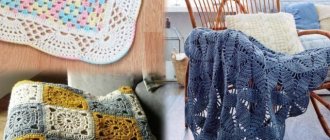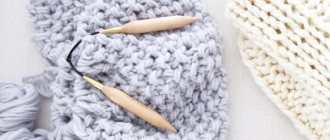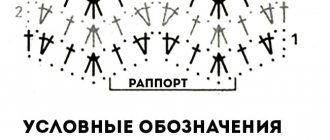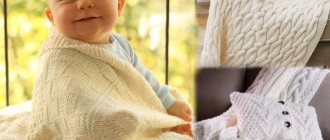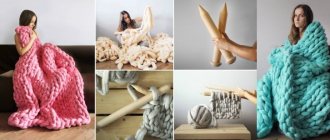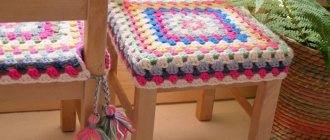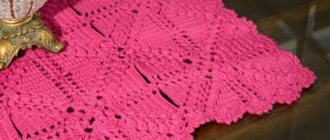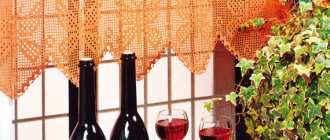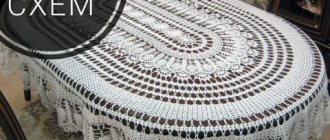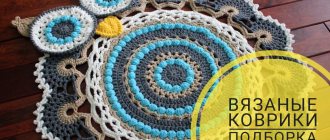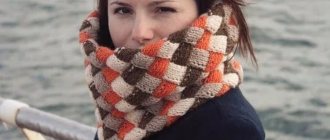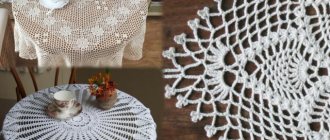A voluminous knitted blanket is comfort that is now in fashion. This article describes cool ways to knit blankets from different threads.
Every woman tries to decorate the interior of her apartment or house in a fashionable and stylish way. Some people buy various interesting things in stores, while others create masterpieces with their own hands. Recently, needlewomen have been decorating their homes with comfortable and cozy large-knit merino wool blankets.
- This fashionable item can be used to decorate a sofa or armchair. This blanket can also be given as a gift for any occasion.
- There is nothing more pleasant than being covered with such a soft and gentle blanket on a winter evening, sitting with a book in your hands or a cup of hot cocoa with milk.
- Therefore, these blankets are popular, and some knit them to order, and other craftswomen even opened a business and sell these products.
- In this article we will tell you where to buy such a blanket cheaply.
- You will learn about cool knitting methods that will help you quickly and easily create this masterpiece from merino or other threads.
What are rugs, blankets, and bedspreads made from in large, voluminous knitting: wool, yarn for rugs
Alpaca wool blankets
Initially, craftswomen around the world began to knit such a blanket only from soft natural merino or alpaca sheep wool. After all, the first purpose of a blanket is comfort and warmth, and it is the wool of these animals that perfectly copes with such requirements.
Now you can buy threads for large knitting with the addition of synthetics, and airy acrylic is also suitable for this type of knitting. Of course, acrylic and synthetic blankets will not be as warm as wool ones, but they can be washed frequently and are an excellent solution for those people who are allergic to natural wool.
Selecting yarn for knitting a blanket, taking into account its characteristics
By using the right material for the chosen blanket model, you can achieve excellent results. But to understand whether the thread will fit well in the pattern, you need to take into account the main characteristics of knitting threads.
Cotton threads
Cotton is often used to create lace motifs. Its thread is quite soft and obedient, the weaving is dense. When working, it does not fluff up, lies flat and allows you to create openwork designs of extraordinary beauty and clarity. This is an excellent yarn for newborns; it is chosen for knitting children's holiday blankets for discharge.
Mercerized cotton threads have a more rigid structure and a light natural shine to the surface. A blanket made from such yarn will be more dense and “spiky”, will hold its shape perfectly and can be easily cleaned of dirt. However, the use of such yarn for creating children's blankets is not advisable, since the rigid structure is not very pleasant to the body and can irritate delicate children's skin.
In addition to cotton, you can successfully use bamboo and linen yarns. At the same time, we must not forget that each thread has its own unique structure and, before purchasing a complete set, it is necessary to correctly evaluate its properties on a small test sample.
Wool yarn
Wool is a universal material for knitting blankets. A huge assortment and a wide variety of wool threads allow you to create blankets of almost any thickness and density.
Finer types of wool knitting threads are chosen to create the finest lace bedspreads. Merino wool is the softest . It has a delicate structure and thin, neatly twisted threads. In addition, it is considered completely hypoallergenic and is often used to create blankets and envelopes for the youngest users.
Alpaca and Angora rabbit wool has downy threads. They give the product extraordinary softness and a delicate, pleasant-to-touch surface. This blanket will perfectly complement the interior, warm you up on a cold evening and add a little warmth and comfort to any home.
Medium-thick sheep's wool yarn is perfect for creating large, voluminous designs. Knitted braids and all kinds of weaving are a win-win option for making a warm blanket. Volumetric patterns give the blanket additional thickness, making it softer and warmer.
Thick, super thick and giant wool threads are a very popular material for creating blankets. The motif of the pattern, as a rule, comes down to ordinary garter stitch, but at the same time the loops turn out to be large, airy and look very impressive. Bedspreads are knitted with the largest knitting needles or simply by hand.
A blanket made from giant yarn has a number of significant disadvantages that every craftswoman who decides to create such a miracle should be aware of:
- thick threads are not twisted into a bundle and feel like cotton wool; during work, the thread can split - this somewhat complicates the knitting process;
- as a rule, the weight of such a bedspread can exceed three kilograms - using it as a blanket or cape is almost impossible;
- the product turns out to be voluminous, which makes caring for it very difficult;
- the high price of the material makes needlework not the most affordable, and the cost of the finished product is several times higher than the cost of such a blanket in the store.
Plush for fluffy things
Plush yarn has an unusual fluffy structure, and the fibers fit so tightly together that they actually resemble faux fur. This is most often made from synthetic acrylic or viscose thread . Sometimes on sale you can find plush thread with the addition of cotton fiber.
Soft blue threads forgive almost any mistakes in knitting. The fabric turns out velvety, very soft and warm. Plush blankets are perfect for the little ones. Very short, dense fibers do not come out of the fabric and do not get into the baby’s face. The products are pleasant to the touch and very warm.
Despite the fact that acrylic and viscose do not cause allergies or irritation on delicate baby skin, you should still remember that synthetics do not allow air to pass through well and can cause diaper rash. You should not leave your child wrapped in such a blanket for a long time.
Turkish yarn Alize Puffy is one of the most interesting solutions among the entire range of plush yarns for blankets. Throughout the entire length of the thread there are a large number of loops, with the help of which weaving occurs.
Knitting a blanket from Alize Puffy does not require special skills, knitting needles or a crochet hook. The whole process occurs with the help of hands and comes down to threading one loop through another. To create a fabric with airy braids and intricate weaves, all you need is desire and quite a bit of practice.
Knitting a voluminous blanket, bedspread, coarse knit blanket for children: diagram, description
Blanket made of thick yarn
A voluminous blanket will perfectly decorate a child's room. It can be placed on the bed or on the floor to keep your baby warm and cozy. It is necessary to knit such a product in the same way as for adults: in stockinette stitch. To create a small blanket, cast on no more than 15-20 stitches. You also need to knit no more than 20 rows in length. To create this product you will need no more than 1 kg of merino wool. Find the knitting pattern and description above in the text.
Purposes of the blanket
Different types of blankets are suitable for different household needs. Thus, a yarn that is excellent for a night blanket may be completely inapplicable to a lace bedspread and muslin.
The bedspread is used as a decorative element of the interior. Any type of yarn can be used in its production. It is important to understand that the surface of the blanket will serve as a kind of protective cover for a bed or sofa; it will have to take on all the “blows” of fate.
When choosing yarn for such a blanket, you should pay special attention to the ease of care of the product during operation. The best solution can be all types of synthetic threads: acrylic, viscose, polyamide. Such bedspreads can be easily washed by hand or in washing machines on a delicate cycle and will retain the shape and appearance of a new product for a long time.
The blanket has a number of features that you should pay attention to when choosing yarn. Covering the body at night, it has direct contact with the skin, so it must be breathable and comfortable.
Soft natural threads are best suited for knitting blankets: cotton, merino wool, alpaca, angora. When choosing wool, it is important to pay attention to the softness of the thread; prickly and hard fibers are completely unsuitable for this.
Blankets for newborns can be divided into two groups: a blanket for sleeping and an envelope for walking outside. Based on the application, the yarn is also selected.
Soft merino wool, mixed fabrics, plush with natural fiber are perfect for a warm night blanket. In this case, the use of pure synthetic threads is not permissible, as they do not allow air to pass through well and can cause overheating of the baby and diaper rash on the skin.
An envelope for discharge or a warm blanket for walking can be knitted from any yarn, including synthetic, since it does not have direct contact with the skin and, as a rule, is used instead of outerwear.
Very beautiful models are made from plush threads; such a blanket can be decorated with mischievous bunny ears and a tail. The most important thing is that the decorative elements do not interfere with the child.
Knitting a voluminous blanket, bedspread, coarse knit blanket with the Marshmallow pattern: diagram, description
Blanket knitted with the Marshmallow pattern
Using this pattern you can create a delicate and weightless blanket from merino wool. But this pattern is crocheted. Therefore, stock up on the necessary materials and tools, as well as patience and free time. Here is a diagram describing how to knit such a pattern:
Knitting pattern for the Marshmallow pattern
Description of knitting pattern Marshmallow
How to buy a thick knit merino wool blanket in the Aliexpress online store: links to the catalog
Alpaca wool blanket on Aliexpress
Merino blankets are very expensive, since threads from the wool of these animals are brought from other countries. Even if you buy threads and knit a blanket yourself, you will have to spend a considerable amount of money. Therefore, many people go shopping on Aliexpress , since on this online trading platform you can cheaply buy high-quality and fashionable things.
- To order such a blanket on Ali, you must first register on this site.
- How to do this correctly is written in this article on our website .
- After registration, enter your address and log into your account.
- Enter the following words into the site search: “ merino wool blankets ” or click on the link located in these words, and you will be taken to a catalog with a huge selection of high-quality knitted blankets.
- Then select the blanket model you like and click on its image.
- You will be taken to her page. Set the color and size of the product. Click "Buy" .
- Then check all the details and continue with registration.
All that remains is to pay for the goods in a convenient way and wait for delivery to the specified address.
The choice of yarn depending on the chosen knitting technique
Experienced craftswomen choose yarn, focusing primarily on the technology for creating a particular model.
Patchwork is a technology for assembling a single fabric from scraps. In the case of knitted blankets, individual related motifs are used, connected to each other. Skilled needlewomen use remnants of thread from past projects.
The motives for the plaid are varied. The entire blanket can be created from threads of one, two or several colors. All the pieces can be the same or completely different - it depends only on the imagination of the master and the desired result.
Both fine and medium-sized yarn are suitable for knitting prefabricated patterns. The main rule when choosing is that all threads must be the same thickness. It is also important to remember that the thicker the thread, the rougher the pattern. Thick thread makes the blanket very heavy and makes the job of sewing the pieces together more difficult.
Bavarian knitting is a technique of crocheting a single fabric from air loops. A distinctive feature is knitting small circles without breaking the thread. By combining different colors with each other, you can achieve very interesting and original designs.
For knitting in this technique, it is best to use thin and medium wool threads. And, if you decide to knit a blanket from multi-colored yarns, you need to choose threads of the same thickness.
The Scandinavian method (double-sided jacquard) is a rather complex type of knitting. The peculiarity of this technique is in the drawing. The blanket is knitted from two threads of different colors. As a result, the chosen motif is clearly visible from both the front and back sides.
This technique can be worked using any type of yarn. Alpaca, merino, and angora rabbit wool are excellent. Blankets knitted from plush yarn look very beautiful.
Openwork and lace blankets are valued for their extraordinary beauty of execution and airy structure. Of course, such work requires a lot of effort, because the perfect pattern is created thanks to the endless patience of the craftswoman. But the result certainly pleases both the needlewoman herself and everyone around her.
There are a huge number of patterns for knitting lace motifs indicating the specific yarn for a particular pattern. The thinnest blankets are made from natural materials, synthetic threads or mixed yarns. You can create lace from thin wool, acrylic and viscose.
The thickness of the yarn may vary depending on the chosen blanket model. Here it is important to take into account one single rule: the tighter the thread is twisted, the clearer the pattern will be. Down lace is a completely different type of openwork; the motif of the design is not clearly visible, but can only be guessed on the canvas, covered with a continuous veil of down.
Beautiful handmade rugs, blankets, bedspreads with large voluminous knitting: photos
Look at the range of colors available in merino wool threads. Each craftswoman can choose a suitable color for herself and create a fashionable interior decoration.
Alpaca wool blanket
Merino wool bedspread Merino wool bedspread Merino wool bedspread Merino wool bedspread Merino wool bedspread Merino wool bedspread Merino wool bedspread
Merino wool blanket
Please note that a knitted blanket made of merino wool with purl stitch does not look as impressive as a piece created with stockinette stitch. Try to knit such a piece of furniture and your guests and household members will be delighted, and your friends will beg you to knit such a delicate and soft interior decoration for them.
How much yarn, how much time
Usually, to knit a blanket with your own hands, you use wool or half-wool merino roving without twisting or felted tape. There are craftswomen who prefer to knit blankets from knitted yarn. Although, according to others, such products are not soft and comfortable enough.
Yarn for hand knitting has two types of markings: in grams and in meters. In the master classes offered, it is rare to see the number of skeins. And each knitter has her own system for determining the required number of threads: for some it is easier to navigate in grams, while others prefer to calculate by footage. This is a matter of personal preference.
On average, for a small children's blanket measuring 80x120 cm, you will need 2 kg of merino fiber. We emphasize that this is an average value. Adult rectangular products close to the standard, measuring 100x150 cm, will require approximately 3 kg of yarn. Well, if you decide to knit a bedspread for a wide double bed (150x200 cm), then you need to have about 6 kg of wool in stock.
Large knitted blankets look stylish, original and impressive.
The main advantage of voluminous knitted blankets is that such a product can be knitted in just a few hours. Moreover, today technologies are available in which no tools are required for knitting: only hands and yarn (no hook, no knitting needles!). And even beginning craftswomen can do this.
Large knitted blankets do not require sophisticated patterns; very often the pattern is a stockinette stitch. Therefore, the answer to the question: how to make a blanket is extremely simple. After all, in order to knit a fabric with stockinette stitch, the skills of a professional knitter are not required.
A large knitted blanket, regardless of whether it is knitted by your own hands or purchased, is always a spectacular accent in the interior. The right yarn will make it a functional accessory, and a spectacular color scheme will add zest to the design of the room.
